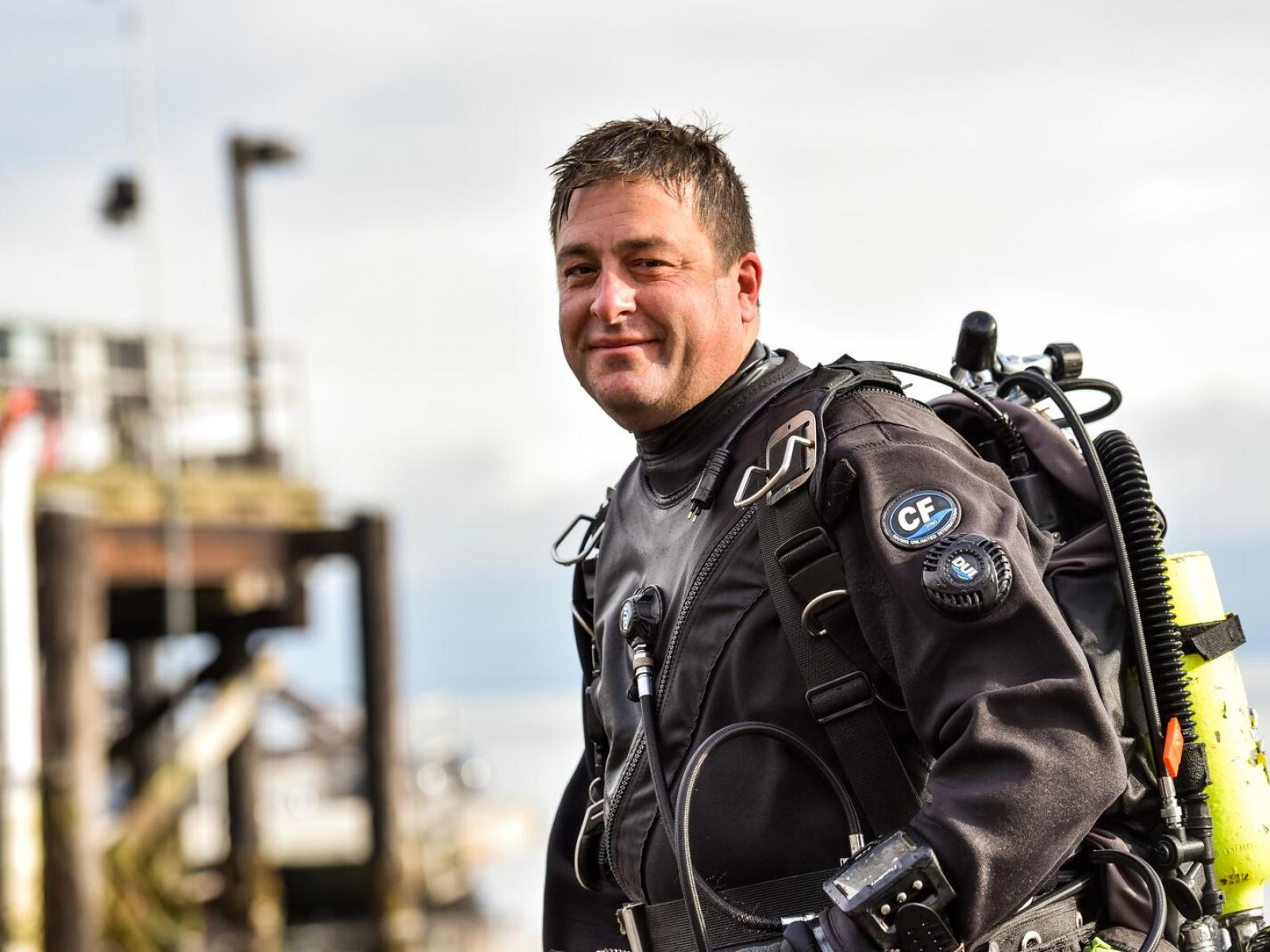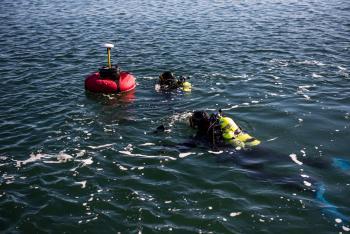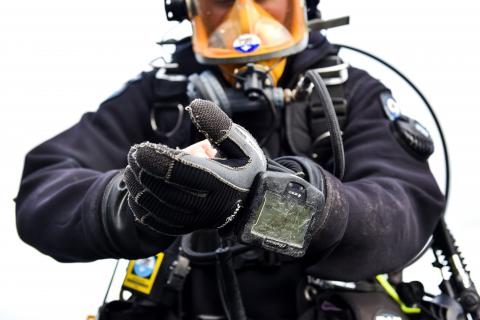Diving into Marine Renewable Energy Research with John Vavrinec

John Vavrinec
Photo by Andrea Starr | PNNL
Have you ever thought about being a professional scientific diver? Pacific Northwest National Laboratory (PNNL) dive officer John Vavrinec shares his experience as a scientific research diver working to support the Triton Initiative. The mission: to enhance environmental monitoring for marine energy.
Vavrinec is a senior staff scientist at PNNL’s Marine and Coastal Research Laboratory (MCRL) who specializes in marine ecology. His winding path to MCRL started with an interest in aeronautical engineering and terrestrial biology which evolved into earning a PhD in Oceanography at the University of Maine after falling in love with diving. He worked with the National Oceanic and Atmospheric Administration in Seattle for several years before coming to Sequim, WA where he has spent 15 years as a researcher and diver studying marine and coastal environments. As a researcher, he primarily studies marine species and ecosystems, performing habitat assessments and large-scale restoration projects. Vavrinec is also a dedicated science, technology, engineering, and mathematics (STEM) ambassador who participates in outreach to local communities in addition to being the dive officer for the PNNL research dive team.
The U.S. Department of Energy Water Power Technologies Office Triton Initiative relies on the dive team, which comprises MCRL scientists and engineers who are trained to conduct underwater research, to execute field deployments. The dive team is a confluence of capabilities, facilities, expertise, and field access that enables testing and development for many applications, including marine energy research. The team’s breadth of capabilities and expertise include habitat assessment and restoration, sensor deployment, maintenance and retrieval of devices, troubleshooting, and deployment of elaborate underwater field plans.
Vavrinec’s role as dive officer means he is responsible for the safety and execution of all projects and field operations that include underwater tasks performed by the team. The training for scientific diving at MCRL is intensive and allows divers to learn the skills and techniques necessary to execute challenging tasks underwater, evaluate complex scenarios, and handle stressful situations that can transpire when working in marine environments. The team’s range of skills and experience, in combination with MCRL’s permitted field location in Sequim Bay, make the dive team aptly suited to support testing and development for Triton’s marine energy technology and methods development projects.

Lab-based research on environmental effects of marine energy has contributed substantially to our understanding of the issues, however, it cannot mimic all the complexities of marine environments. The dive team provides the Triton Initiative with the opportunity to research environmental monitoring technology in a controlled field environment. Triton’s testing of the University of Washington's 3G-Adaptable Monitoring Package for the Triton Fish Mesocosm – Pilot Study is a great example of field research that is helping move the industry forward. Measuring and observing how fish behave around marine energy devices, such as tidal turbines or wave energy converters, is very difficult. Laboratory settings control variables that can alter fish behavior, which is why it is important to observe how fish act around marine energy devices in a more realistic environment (such as Sequim Bay) in order to best assess potential impacts at a deployment site. The dive team makes this research possible.
In order to execute this particular study, a complex hydrophone array was deployed underwater around the 3G-AMP. The hydrophone array enabled precise tracking of tagged fish and the 3G-AMP dually served as a sensor package and as a tidal turbine surrogate during this pilot study. The field setup for this project was demanding and required the dive team to deploy heavy equipment and many sensitive instruments in specific locations within the study area. This project demanded an expert understanding of tides, currents, and the idiosyncrasies of underwater labor in low-visibility conditions. The dive team beautifully executed this challenging task, allowing the Triton Team to move one step closer to understanding marine energy impacts on fish. Much of Triton’s success with underwater deployments can be attributed to Vavrinec’s commitment to safety and steadfast leadership.
The dive team has also been involved with numerous field deployments for the Triton field trials and other DOE Funding Opportunity Announcement awardee projects, including:
- BioSonics, Inc. Perimeter Detector
- Florida Atlantic University’s Unobtrusive Multi-Static Serial LiDAR Imager
- Integral Consulting's NoiseSpotter technology and benthic habitat mapping project
- University of Washington’s 3G-AMP and Drifting Acoustic Instrumentation SYstem technologies
- Woods Hole Oceanographic Institution’s electromagnetic field (EMF) detection system
For many of these projects, the team helped deploy and secure equipment in Sequim Bay, maintained and retrieved sensors, posed as underwater targets, and acted as photographers and videographers so researchers on the surface could get a peek of what has gone on below the water’s surface.
One of Vavrinec’s favorite projects to work on was the UMSLI project—an advanced remote sensing method designed to detect and classify marine animals in real-time using LiDAR. To help strengthen the system’s detection and identification algorithms, divers were tasked with swimming around the UMSLI with fiberglass turtles and barracudas as targets for the system to identify. Much of the work for this project was done at night with only radio communications from the boat crew to guide the divers. Vavrinec exclaims, “there was one night with amazing bioluminescence that was so bright it was disorienting–like fireworks exploding in front of your face. The bioluminescence was so intense it would outline my dive buddy well enough that I could see her whole silhouette.” Moments like this are what make research diving truly remarkable and provides Vavrinec and his fellow divers with experiences they will never forget—all while helping progress the marine energy industry in a meaningful way.
Though research diving can be full of exhilaration and wonder, there are romanticized notions about diving. While most people think of tropical settings with clear, warm water, Vavrinec’s team works in locations typically no warmer than 55˚F, often with visibility less than 10 feet, and strong, chilling currents. Simple physical tasks are much different underwater than on land, such as moving heavy objects. On land, when you push an object, typically your force propels that object forward. When a diver pushes something heavy underwater, typically the diver moves rather than the object because of the buoyancy associated with the salty oceanic waters. These physical changes alter the divers’ approaches to working underwater, such as learning to brace themselves with tools, maneuvering their fingers while wearing thick cold-water gloves, measuring time underwater based on the amount of air they are carrying on their backs, or adapting to changes in visibility because they stirred bottom sediments. Luckily, the dive team’s state-of-the art-equipment helps them adapt to situations that arise when working on these projects. For example, while helping with sensor testing for the NoiseSpotter project, the bubbles that the divers produced while breathing underwater interfered with an acoustic signal that needed to be detected by the NoiseSpotter’s sensors. To resolve this, the divers shifted to rebreathers, a type of dive technology that does not produce bubbles, and the noise of the bubbles no longer interfered with signals. With each project, Vavrinec enjoys finding ways to help researchers work through these types of logistical challenges in the field.
In addition to their skilled deployment of sensors and adapting to field conditions, the diverse research experience of PNNL’s divers is an asset to Triton because they are also scientists. This gives the team a unique perspective and understanding of the research they are contributing to. “All our divers have degrees in science or engineering and can look at problems and issues with a different lens than a normal commercial diver,” says Vavrinec. This dynamic improves research because the members of the dive team can provide insights into sampling design and research implementation from both lenses. This leads to strategic field plans that are designed specifically for effective diving, all while making the best decisions for the research.
Simply put, Triton’s research wouldn’t be possible without the hard work and expertise of Vavrinec and the whole PNNL research dive team. Vavrinec enjoys working on Triton projects because he feels the research and development is pushing the boundaries of innovation. The dive team always has unique challenges to overcome because much of Triton’s research has never been done before. As Triton continues to pave the path for researching environmental effects of marine energy technologies, Vavrinec will be there every step of the way to work through field challenges and help make Triton’s research visions come to life.

Written by Cailene Gunn.
Subscribe to our monthly newsletter here.
Published: September 8, 2020